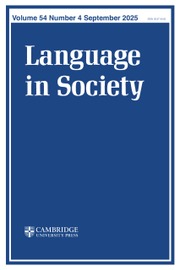Crossref Citations
This article has been cited by the following publications. This list is generated based on data provided by
Crossref.
Kroskrity, Paul V.
2010.
Handbook of Pragmatics.
p.
1.
O'Rourke, Bernadette
2011.
Whose Language Is It? Struggles for Language Ownership in an Irish Language Classroom.
Journal of Language, Identity & Education,
Vol. 10,
Issue. 5,
p.
327.
McEwan-Fujita, Emily
2011.
Language revitalization discourses as metaculture: Gaelic in Scotland from the 18th to 20th centuries.
Language & Communication,
Vol. 31,
Issue. 1,
p.
48.
Ciriza, Maria del Puy
2012.
Basque natives vs. Basque learners: The construction of the Basque speaker through satire.
Discourse, Context & Media,
Vol. 1,
Issue. 4,
p.
173.
Hiss, Florian
2013.
Tromsø as a “Sámi Town”? – Language ideologies, attitudes, and debates surrounding bilingual language policies.
Language Policy,
Vol. 12,
Issue. 2,
p.
177.
Armstrong, Timothy Currie
2013.
“Why Won't You Speak to Me in Gaelic?” Authenticity, Integration, and the Heritage Language Learning Project.
Journal of Language, Identity & Education,
Vol. 12,
Issue. 5,
p.
340.
O'Rourke, Bernadette
and
Ramallo, Fernando
2013.
Competing ideologies of linguistic authority amongst new speakers in contemporary Galicia.
Language in Society,
Vol. 42,
Issue. 3,
p.
287.
Mori, Miki
2014.
Conflicting Ideologies and Language Policy in Adult ESL: Complexities of Language Socialization in a Majority-L1 Classroom.
Journal of Language, Identity & Education,
Vol. 13,
Issue. 3,
p.
153.
Smith-Christmas, Cassie
and
Armstrong, Timothy Currie
2014.
Complementary reversing language shift strategies in education: the importance of adult heritage learners of threatened minority languages.
Current Issues in Language Planning,
Vol. 15,
Issue. 3,
p.
312.
Dombrowski, Lindsay Milligan
2014.
Additional language education and language development goals: the example of Gaelic (learners) education in Highland Council, Scotland.
British Educational Research Journal,
Vol. 40,
Issue. 2,
p.
261.
Wilce, James M.
2014.
Current Emotion Research in Linguistic Anthropology.
Emotion Review,
Vol. 6,
Issue. 1,
p.
77.
Hornsby, Michael
2015.
Constructing a Lemko identity: tactics of belonging.
International Journal of Multilingualism,
Vol. 12,
Issue. 1,
p.
1.
Koven, Michele
2015.
Language Awareness and Multilingualism.
p.
1.
Liang, Sihua
2015.
Language Attitudes and Identities in Multilingual China.
p.
91.
Paterson, Lindsay
and
O'Hanlon, Fiona
2015.
Public views of minority languages as communication or symbol: the case of Gaelic in Scotland.
Journal of Multilingual and Multicultural Development,
Vol. 36,
Issue. 6,
p.
555.
Liang, Sihua
2015.
Language Attitudes and Identities in Multilingual China.
p.
37.
McLeod, Wilson
and
O’Rourke, Bernadette
2015.
“New speakers” of Gaelic: perceptions of linguistic authenticity and appropriateness.
Applied Linguistics Review,
Vol. 6,
Issue. 2,
p.
151.
Liang, Sihua
2015.
Language Attitudes and Identities in Multilingual China.
p.
139.
Nance, Claire
2015.
‘New’ Scottish Gaelic speakers in Glasgow: A phonetic study of language revitalisation.
Language in Society,
Vol. 44,
Issue. 4,
p.
553.
Cortès-Colomé, Montserrat
Barrieras, Mònica
and
Comellas, Pere
2016.
Changes in immigrant individualsʼ language attitudes through contact with Catalan: the mirror effect.
Language Awareness,
Vol. 25,
Issue. 4,
p.
272.


